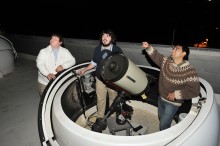Small Telescope, Big Discovery
In June 2015, Assistant Professor of Physics &Astronomy Dipankar Maitra and John Scarpaci ’17 had front row seats when a black star erupted almost directly over Norton. Occurring 8,000 light years away within the Milky Way, the event involved a black hole 8-to-15 times more massive than our sun, and a companion star a little smaller than the sun.
After this amazing good fortune the hard work began, comparing their own observations of the outburst with simultaneous data from NASA’s Swift satellite and European Space Agency’s INTEGRAL satellite. Using analysis of the optical data obtained from Wheaton along with ultraviolet and x-ray data from Swift and INTEGRAL, Maitra and Scarpaci concluded that the light was produced by material defying the immense gravity of the black hole and flowing away from it at speeds just below the speed of light.
“This was a totally unanticipated event and made us change all our previous plans for the summer,” said Professor Maitra, who has worked with Scarpaci on various astronomy projects since fall 2013.
Scarpaci said observing the highly energetic and rapidly varying outburst from the black hole was both exciting and awe-inspiring. “I couldn’t stop myself from losing sleep over the analysis of the images. What we saw in our data is not what we would usually expect from a typical jet-dominated outburst.”
Astronomers still do not fully understand why matter falling towards a black hole sometimes manages to evade the hole’s fatal attraction, gets turned away, and is ejected at high speeds.
“This means we may have to go back to our drawing boards and re-evaluate or modify our existing ideas about the process of accretion onto black holes,” Maitra said.
 In Maitra’s view, student-faculty research provides a transformative experience for intellectually curious students by encouraging independent thinking, fostering creativity, and promoting teamwork and collaboration.
In Maitra’s view, student-faculty research provides a transformative experience for intellectually curious students by encouraging independent thinking, fostering creativity, and promoting teamwork and collaboration.
“What fascinates me the most is that once the spark is ignited and a student realizes that they are contributing something substantial and new to cutting-edge research, they take the project much further themselves,” Maitra said.
Also, student participation frees him up to think more about the implications of research findings and to see where results fit, or do not fit, in the bigger picture, he said.
Their article was published in the December 2017 issue of The Astrophysical Journal. Their multiple collaborations are described in the Spring 2016 issue of the Wheaton Magazine. This text is drawn from the article and a December 16, 2015 Wheaton News article.